Distinguished Critique: JLA: Year One Review
This 1998 series serves as a very entertaining post-Crisis update of the Justice League's origin, finding strength in examining the core characteristics of its heroes
—by Nathan on September 1, 2023—
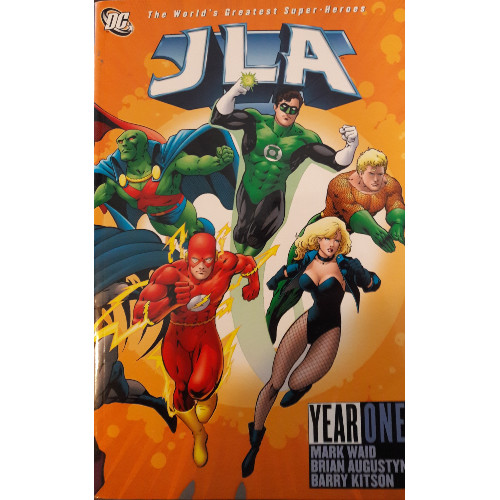
Years after DC rebooted its continuity with Crisis on Infinite Earths but a few years before Mark Waid penned the then-definitive retelling of the Man of Steel’s origin in Superman: Birthright (though, I guess, according to Doomsday Clock, each version is technically definitive), the writer, along with the late Brian Augustyn, retooled the Justice League’s history in JLA: Year One. Much like Frank Miller had redefined Batman in his own “Year One” arc, or like Jim Owsley, Keith Griffen, and Gerard Jones revamped Hal Jordan’s Green Lantern in Emerald Dawn, so too were Waid and Co. responsible for recreating the League’s early days.
Unable as I am to remark on the Justice League’s original adventures from when they first debuted, I would like to comment on this updated origin for the team. Our writers go all the way back to events kicking off in 1962’s Justice League of America #9, pulling from that foundational single issue the basic plot details from which they construct this series. The result is a character-driven narrative which properly updates the League for the post-Crisis world.
JLA: Year One
Writers: Mark Waid, Brian Augustyn
Penciler: Barry Kitson
Inkers: Barry Kitson, Michael Bair, John Stokes, Mark Propst
Colorist: Pat Garrahy
Letterer: Ken Lopez
Issues: JLA: Year One #1-12
Publication Dates: January 1998-December 1998
Note: save for some minor edits, this blog is the same as it was when I originally posted it to Hubpages
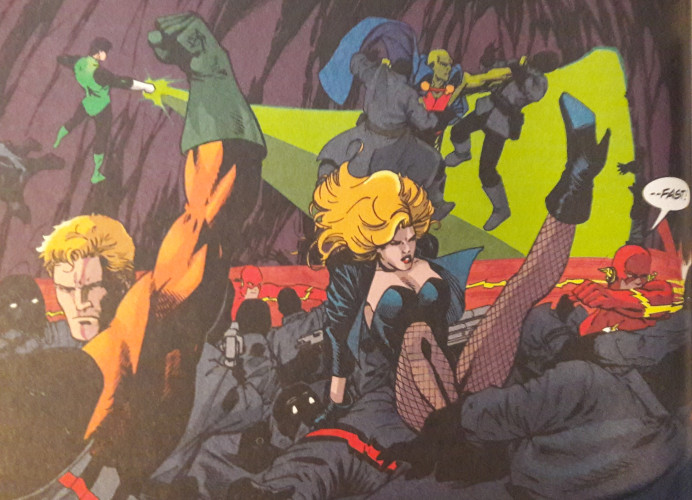
“Refreshing” is a word I’ll use to describe Waid, Augustyn, and Kitson’s series. Though the League, according to JLA #9, initially included Batman, Wonder Woman, and Superman in its ranks, Waid, Augustyn, and Kitson choose to scale back on how often those famed heroes appear in this series. Batman and Superman’s appearances are limited; Wonder Woman doesn’t show up whatsoever. Superman, near the series’ end, even falls prey to the League’s alien adversaries, relying on the League for rescuing.
Green Lantern, Black Canary, Aquaman, Martian Manhunter, and the Flash form this team (with the promise that others, such as Green Arrow, will eventually gain membership), and as the series kicks off, our creators craft a less-than-stellar band of individuals. Waid and Augustyn largely coast over the events of JLA #9, picking up where the dust settled in that issue, curiously axing DC’s top trio of heroes in favor of the five mentioned above. Each hero has had their own fair share of fame–and I think modern audiences can certainly attest to characters like the Flash and Aquaman better now than perhaps in the past–but the writers’ decision to not include particular characters as heavily feels unique and engaging. It allows them room to play with team dynamics without the characteristically morose Batman suspecting every motive (a concept Waid would later touch on in the Justice League’s “Tower of Babel” story arc) or the nearly invulnerable Superman hovering over everyone, ready to repel bullets.
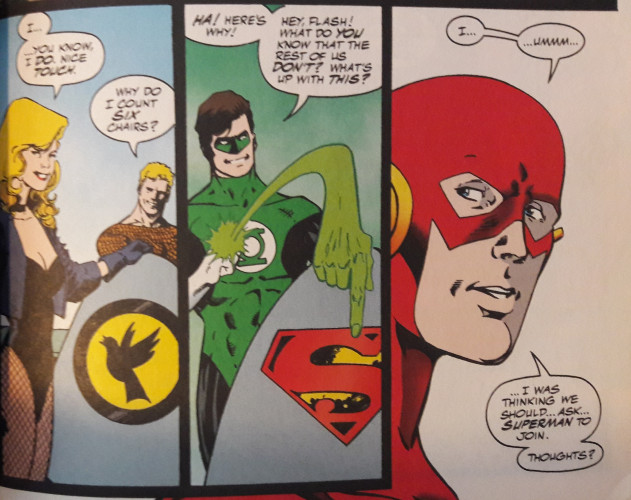
These are characters who really have to find themselves just as much as they need to find each other. We’re cast into a world where heroes seem the norm–aside from Batman and Superman, the Blackhawks, Doom Patrol, and the Justice Society of America all pop up as established superhuman outfits–and where the Justice League is trying to find its footing. Again, characters like the Flash, Green Lantern, and Aquaman have been around for years in our world, steadily gaining popularity, but the writers treat these Leaguers as if they’re the new kids on the block. These feel like slightly post-“Year One” versions of each hero–as if they’ve had some experience crime-fighting and shaping their identities but not a whole lot of time to do so. Our writers’ take is refreshing, casting these typically experienced heroes in the mold of junior Justice Leagues, unsure of one another and their own potential.
The writers use this tension to great effect, crafting excellent conflict between characters. From the get-go, Hal Jordan is cast in the role of a snobbish, self-appointed leader, similar to his depiction in Emerald Dawn. He’s an arrogant risk-taker who shoves his way into a position of leadership because he genuinely believes he knows better. Barry Allen is uncertain and unsteady on his feet (funny for a guy who runs), not sure of his role within the League and, at first, a little cowed by Jordan’s abrasive behavior. John Johns, the Martian Manhunter, wavers between a man who trusts little and may be unable to be trusted himself. Different characteristics put our protagonists at odds with one another even as they all work towards common goals.
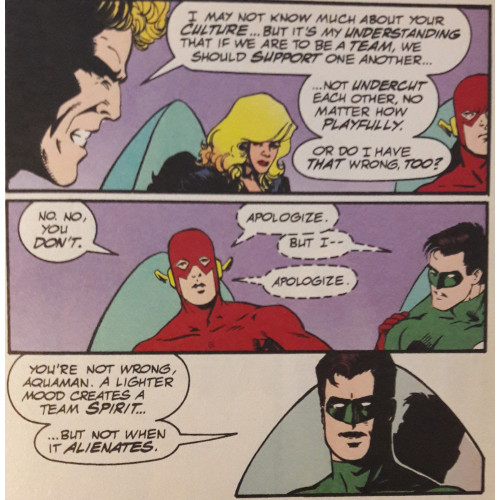
Outside of conflict, the writers inject a series of moments which help shape our characters in other ways. Aquaman is not only facing the pressures (sorry, not sorry) of heroism but humanity as well. He interacts with a world he doesn’t understand, a language he’s trying to learn, barriers to being fully human. Black Canary behaves as if she’s trapped in the mold of her mother, constantly referencing her adventures with the JSA instead of becoming her own person. Through these personal conflicts, our writers add depth to each of the characters, forming well-rounded individuals who must grow not only in response and relation to each other but also on their own.
Each character is, nicely, given that opportunity to grow. Perhaps thanks in part to the series’ twelve-issue length, our writers craft a variety of scenes between our characters and with our protagonists individually. We get to see Hal’s character come out as both a hero and a pilot; we explore Barry’s relationship with the future Iris Allen and his brief smittenness with Canary as the Flash; we watch Aquman realize his own naivety and the ways people take advantage of him. The series allows our characters to grow as people as well as heroes, providing chances to overcome internal struggles and external conflicts. Trust and personal responsibility are powerfully present themes through the entire arc, as each character comes to understand themselves and the people they interact with better.
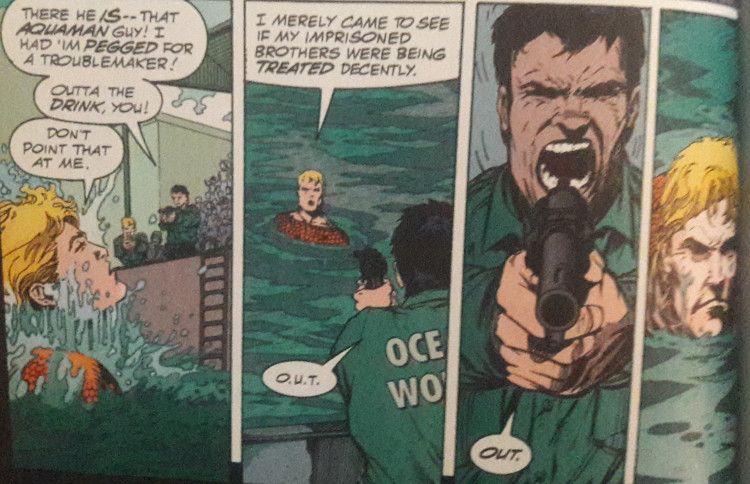
Aside from the fantastic character work, our writers handily create a well-told adventure that dips and rises in various directions yet never feels lost. A plotline continuing the events of the original JLA #9 threads through the entire series, culminating in a final issue that scrounges up a whole bunch of DC superheroes for an awesomely climactic showdown between DC’s powerful pantheon and the series’ main manipulative menaces. Yet this plot serves as a backdrop for plenty of other misadventures. The League teams with Doom Patrol to take out the villainous Brotherhood in an issue where the Leaguers temporarily lose their powers in creative ways–Canary’s voice box is stolen, the Flash loses his legs, Green Lantern loses an arm. The Leaguers deal with the mystery behind how they receive funding, and though they themselves never learn the answer, the solution is a very rewarding revelation for the reader. These shenanigans, like the characterization, make for a well-rounded narrative not completely dependent on the overarching plot.
Additionally, some moments just really smack of our writers having fun, particularly in the way easter eggs and references to DC continuity are injected. Early on, the League seeks help from Ted Kord, the future Blue Beetle; when Superman declines an invitation to join the League, Green Lantern hurls the Man of Steel’s chair into space, the design looking like a spaceship leaving Earth (very clever); the League use Lucas “Snapper” Carr as an intern, a nice deep dive into DC’s character roster to create an “everyman” character of sorts. These and other references to larger DC continuity showcase the love the creative team have for the universe, as well as the wherewithal to retroactively foreshadow or comment on certain events and characters.
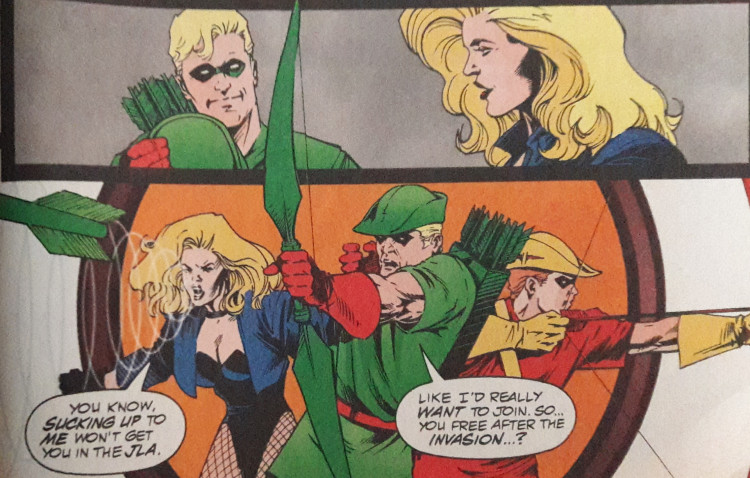
The one place where I find that Year One flags is in its use of Vandal Savage. Though the rest of the plot feels well-woven and steadily builds through the series, Savage’s appearances are sporadic. He’s not even much of a minor character in the series, and his final appearance feels like a deus ex machina moment. Perhaps if he had been teased or utilized a little more heavily, his appearances would feel more natural. As it stands, Savage comes across as underused–he’s not even really a villain, and in fact, I do not believe the League meets him at all. Why he shows up is a bit of a mystery…and an unfortunately disappointing one.
Savage’s role notwithstanding, JLA: Year One is a fine update to the team. It doesn’t quite bear the same “updated for the times” emphasis that “Batman: Year One,” Man of Steel, or Emerald Dawn carry with them. Regardless, the series does feel like a more modern reintroduction to the classic superhero team, particularly for those unaware of their previous history. Characters are handled fantastically, and I especially appreciate how the writers crafted strong protagonists out of heroes not named “Superman” or “Batman.” I couldn’t tell you how well-regarded Green Lantern, Aquaman, Black Canary, Flash, and Martian Manhunter were back in the late 90s (except for the fact that both Hal Jordan and Barry Allen were dead), but this is a prime examination of several heroes who formed the core of the JLA when they first banded together in 1960. The series may not necessarily be updated for the times, but it’s certainly a reexamination of the group dynamics the team was born with and a reaffirmation of their longevity and staying power within the DC Universe.